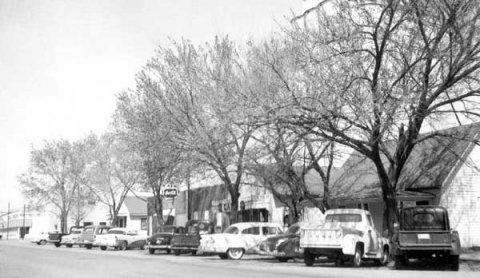Description:

In 1899, a handbill was printed up and distributed by a young merchant in an effort to attract attention to his new 80-acre town site:
Harrah, Oklahoma Territory, twenty miles east of Oklahoma City, offers an excellent opportunity for parties looking for a location as Merchants, Doctors, Mechanics, and others … with good roads in all directions, Harrah Railroad has built a fine freight and passenger depot … Parties desiring lots for bona-fide business purposes can secure the same at any time.”
Frank Harrah had arrived with a sea of other potential settlers participating in the Oklahoma Land Run of 1889. After jumping off the train and running about four blocks, he drove a stake into the ground and spent the rest of the day protecting it from lot-jumpers. He and a neighbor, W.O. Church, ended up sharing a tent and going into business together, first as restaurateurs and later opening a feed and coal business. Success later led him to real-estate development, agricultural investments, and town founder. In February of 1899, he purchased property from Louis and Julia Navarre and platted the town of Harrah where the Choctaw, Oklahoma and Gulf Railroad crossed the North Canadian River.
Making arrangements with officials of the Frisco Railroad, Harrah used cooperative advertisements to recruit immigrants interested in farming, setting up businesses, or establishing homes. By 1901, the little town of Harrah had a population of about 300, along with 13 newly-constructed buildings. The area was also home to a number of Polish families, who had relocated from Arkansas to form the nucleus of Harrah’s Polish community. By 2000, the U.S. Census placed the population at around 4,719.
Harrah was the birthplace of Paul and Lloyd Waner, who played outfield for the Pittsburgh Pirates and earned the nicknames Big Poison and Little Poison. Both brothers were elected to the Baseball Hall of Fame. Tim Holt, the Western film star who appeared along with Humphrey Bogart in Treasure of the Sierra Madre, spent part of his retirement in the Harrah area and is interred at the Memory Lane Cemetery.
Harrah’s school system has earned a reputation as being one of the best in Oklahoma, with students consistently scoring in the upper rankings for state and national achievement scores. The North Canadian River Valley in Harrah is also the winter nesting site of the country’s national symbol, the bald eagle.
Resources:
“Birth of Harrah.” History of Harrah. 2007. http://www.harrah-ok.gov/
Blackburn, Bob L. Heart of the Promised Land: Oklahoma County: an Illustrated History. Woodland Hills, CA: Windsor Publications, 1982.
Faulk, Odie B., Laura E. Faulk and Bob L. Blackburn. Oklahoma City: A Centennial Portrait. Northridge, CA: Windsor Publications, 1988.
Fugate, Francis L., and Roberta B. Fugate. Roadside history of Oklahoma. Missoula, MT: Mountain Press Pub., 1991.
Harrah Historical Society, comp. and ed. Harrah: backward and forward. Wolfe City, TX: Henington Industries, Inc., 1999.